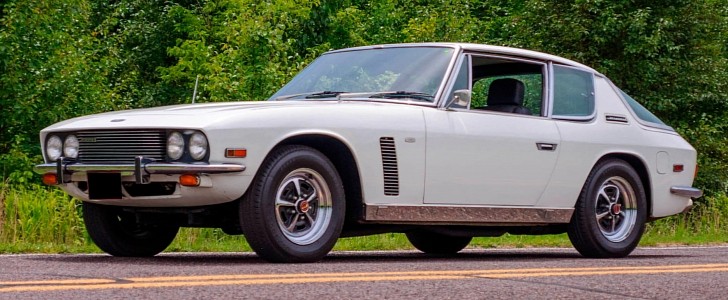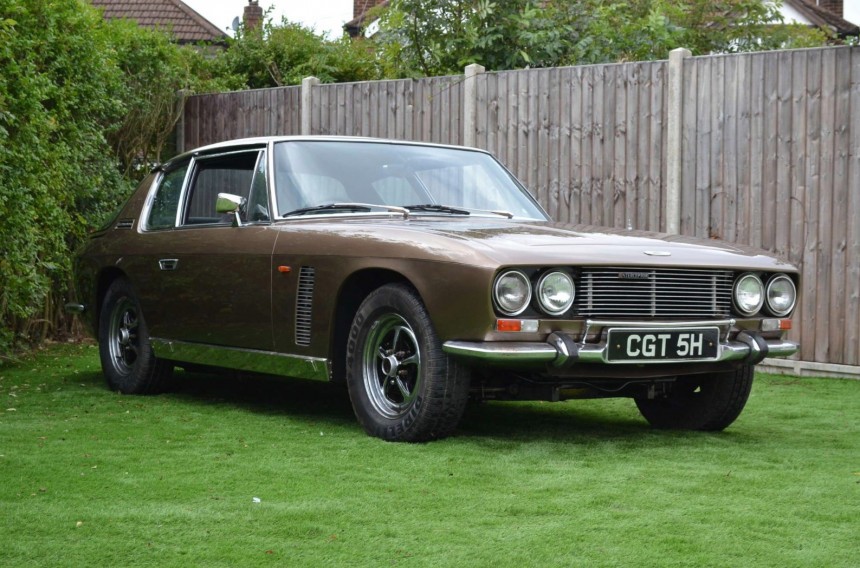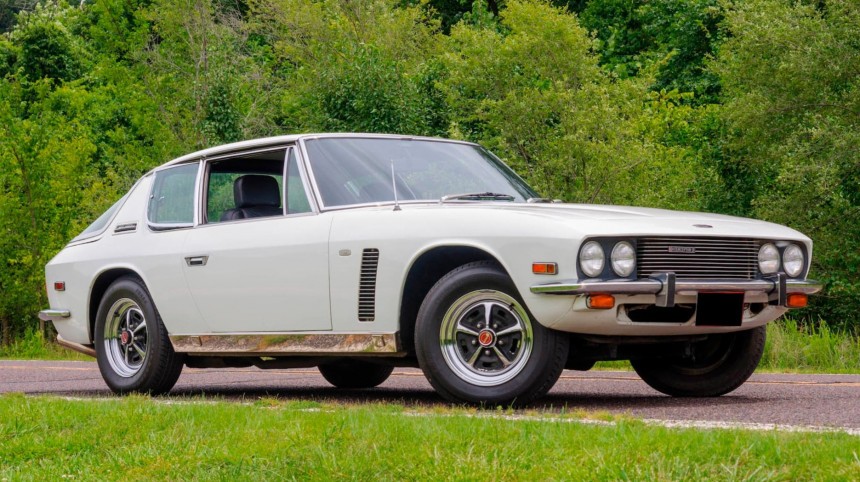Since 1934, Alan and Richard Jensen enjoyed offering ingenious solutions to the big automakers. Being coachbuilders by trade, they combined the best parts from big automakers to build bodies under contract. Early production cars made use of fiberglass and aluminum to yield incredible performance, so the next logical step was more power.
Carroll Shelby had shocked the world by dropping Ford power into compact English roadsters, so Jensen turned to Chrysler. The 383 (6.3L) big block was a favorite among hot-rodders thanks to its wedge-shaped combustion chambers. This was enough to power their 1962 C-V8 to low 14-second quarter-mile times, exposing the limitations of their composite body.
To give in an timeless design, Carrozzeria Touring penned a body that combined the best attributes of an Italian GT along with an innovative hatch-back cockpit. Needing world-class quality control, Vignale offered to build the bodies of steel and ship them to England for final assembly. Seeking a solid foundation, the body itself was engineered to be as strong as a monocoque race car before the chassis and suspension were added. It all came together in 1966, as the Interceptor MK1.
Inside, four adults can comfortably enjoy acres of leather and wood, with full instrumentation from Smiths gauges. Luxury was top priority, so air conditioning, power brakes, windows, and steering were standard equipment. At nearly twice the price of an E-Type Jaguar, it was a status symbol for celebrities and the aristocracy alike. Because the horizontal roof extends past the shoulders of rear passengers, the Interceptor is accepting of your friends while the wrap-around rear glass offers ample cargo space.
Riding on Armstrong Selectaride shocks, the big V8 was mounted behind the front axle to offer an optimal weight distribution. This required a few tricks like mounting the oil filter remotely, but their motives were quickly seen a year later. While looking nearly identical, the Jensen FF arrived in 1967. It was the world’s first 4WD passenger car, and the first to offer Anti-Lock Brakes. Even more expensive, only 320 were built before it was canned in ‘71.
If you need to leave the beaten path, a central locking differential could send power wherever it was needed. The “FF” is a reference to Ferguson Four, the first 4WD farm tractor that revolutionized the productivity of English agriculture. Perhaps the Ferrari FF was named in honor of Jensen’s innovations, but we aren’t holding our breath.
Vignale was forced to close after their founder died in 1969, so Jensen decided to move production in-house to their factory in the Midlands. The MKII debuted later that year, with American buyers in mind. This required styling updates to the bumpers and headlights, and the interior was completely redesigned. Gauges now had their own pods, counter-sunk into the dash and angled at the driver.
The biggest change arrived in the form of the 440 (7.2L) big block. When topped with three two-barrel carburetors, the 1971 Interceptor SP (Six-Pack) offered 385 horsepower and reached 60 mph in 7.1 seconds. With a top speed over 145, the hood louvers are a fair warning to leave this one alone.
The final iteration arrived in 1972, and the MKIII was another leap forward in luxury. Alloy wheels, 8-track stereo, and two new body styles were introduced. The coupe ditched the rear hatch in favor of a vertical rear window over a small trunk, and the convertible tries to make it look decent without a roof. Power began to slip thanks to the oil crises, and Jensen was insolvent by 1975. The last cars were built a year later, and they are among the most desirable English cars of all time.
To give in an timeless design, Carrozzeria Touring penned a body that combined the best attributes of an Italian GT along with an innovative hatch-back cockpit. Needing world-class quality control, Vignale offered to build the bodies of steel and ship them to England for final assembly. Seeking a solid foundation, the body itself was engineered to be as strong as a monocoque race car before the chassis and suspension were added. It all came together in 1966, as the Interceptor MK1.
Riding on Armstrong Selectaride shocks, the big V8 was mounted behind the front axle to offer an optimal weight distribution. This required a few tricks like mounting the oil filter remotely, but their motives were quickly seen a year later. While looking nearly identical, the Jensen FF arrived in 1967. It was the world’s first 4WD passenger car, and the first to offer Anti-Lock Brakes. Even more expensive, only 320 were built before it was canned in ‘71.
If you need to leave the beaten path, a central locking differential could send power wherever it was needed. The “FF” is a reference to Ferguson Four, the first 4WD farm tractor that revolutionized the productivity of English agriculture. Perhaps the Ferrari FF was named in honor of Jensen’s innovations, but we aren’t holding our breath.
The biggest change arrived in the form of the 440 (7.2L) big block. When topped with three two-barrel carburetors, the 1971 Interceptor SP (Six-Pack) offered 385 horsepower and reached 60 mph in 7.1 seconds. With a top speed over 145, the hood louvers are a fair warning to leave this one alone.
The final iteration arrived in 1972, and the MKIII was another leap forward in luxury. Alloy wheels, 8-track stereo, and two new body styles were introduced. The coupe ditched the rear hatch in favor of a vertical rear window over a small trunk, and the convertible tries to make it look decent without a roof. Power began to slip thanks to the oil crises, and Jensen was insolvent by 1975. The last cars were built a year later, and they are among the most desirable English cars of all time.












